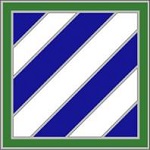Hobby Master HG3705 US M46 Patton Medium Tank - 64th Heavy Tank Battalion, 3rd Infantry Division, Imjin River, Korea, Spring 1951 (1:72 Scale)
"The only way you can win a war is to attack and keep on attacking, and after you have done that, keep attacking some more."
- General George S. Patton Jr., January 1945
 The M46 was an improved M26 Pershing (sometimes named Pershing II) tank and one of the U.S army's principal main battle tanks of the Cold War, with models in service from 1949 to the mid 1950s. It was widely used by some U.S. Cold War allies, especially other NATO countries. The M46 tank was designed to replace the previous M26 Pershings and M4 Shermans.
The M46 was an improved M26 Pershing (sometimes named Pershing II) tank and one of the U.S army's principal main battle tanks of the Cold War, with models in service from 1949 to the mid 1950s. It was widely used by some U.S. Cold War allies, especially other NATO countries. The M46 tank was designed to replace the previous M26 Pershings and M4 Shermans.
After World War II most US Army armored units were equipped with a mix of M4 Sherman and M26 Pershing tanks.
Designed initially as a heavy tank, the M26 Pershing tank was reclassified as a medium tank postwar. The M26 was a significant improvement over the M4 Sherman in firepower and protection. Its mobility, however, was deemed unsatisfactory for a medium tank as it used the same engine that powered the much lighter M4A3. Its underpowered engine was also plagued with an unreliable transmission.
Work began in January 1948 on replacing the original power plant with the Continental AV-1790-3 engine and Allison CD-850-1 cross-drive transmission. The design was initially called M26E2, but modifications continued to accumulate, and eventually the Bureau of Ordnance decided that the tank needed its own unique designation. When the rebuild began in November 1949, the upgraded M26 received not only a new power plant and a main gun with bore evacuator, but a new designation along with a name - simply M46. In total 1,160 M26s were rebuilt: 800 to the M46, 360 to the M46A1 standard.
Pictured here is a 1:72 scale replica of a US M46 Patton medium tank which was attached to the 64th Heavy Tank Battalion, 3rd Infantry Division, then deployed to the Imjin River, Korea, during the spring of 1951.
Sold Out!
Dimensions:
Length: 4-inches
Width: 1-1/2-inches
Release Date: April 2020
 Historical Account: "The Fire Brigade" - During the Korean War, the 3rd Infantry Division was known as the "Fire Brigade" for its rapid response to crisis. 3rd Infantry Division had been headquartered at Fort Benning along with its 15th Infantry Regiment. The 7th Infantry Regiment was located at Fort Devens. 3rd Infantry Division initially arrived in Japan where, as the Far East Command Reserve, it planned post conflict occupation missions in northern Korea. In Japan, their strength was increased by augmentation of South Korean soldiers.
Historical Account: "The Fire Brigade" - During the Korean War, the 3rd Infantry Division was known as the "Fire Brigade" for its rapid response to crisis. 3rd Infantry Division had been headquartered at Fort Benning along with its 15th Infantry Regiment. The 7th Infantry Regiment was located at Fort Devens. 3rd Infantry Division initially arrived in Japan where, as the Far East Command Reserve, it planned post conflict occupation missions in northern Korea. In Japan, their strength was increased by augmentation of South Korean soldiers.
The Division was assigned to X Corps and landed at Wonsan on the east coast of Korea on November 5th, 1950, and received the 65th Infantry Regiment as their third maneuver element before moving north to Hungnam and Majon-dong. At Majon-dong they established a defensive position with the 65th Infantry. 1st and 2nd Battalions of the 7th Infantry were on the left flank. The 15th Infantry was between the 7th and 65th Regiments. 3rd Battalion, 7th Infantry was set as the nucleus for Task Force Dog which was commanded by Brigadier General Armistead D. Mead, assistant 3rd Division commander and sent north to conduct a relief in place with 1st Battalion, 1st Marine Regiment at Chinhung-ni; the south end of the 1st Marine Division and support the withdrawal of 1st Marine Division and Regimental Combat Team 31 from the fighting at the Chosin Reservoir. 3rd Infantry Division's Task Force Dog was the rearguard keeping the pressure off of the Marine column. The division along with the 7th Infantry Division established a collapsing perimeter around the port of Hungnam until the last of X Corps was evacuated. The Division was the last unit to leave Hungnam and was shipped to Pusan where it completed unloading on December 30th and moved north to Kyongju and on December 31st it was placed in Eighth Army reserve for reorganization and reequipping following which it was to move into the Pyongtaek-Ansong area. The Division was then transferred to US I Corps.
In January 1953, the Division was transferred from I Corps. The Division served in Korea until 1953 when it was withdrawn. Notably, the division fought at the Chorwon-Kumwha area, Jackson Heights and Arrowhead outposts and blocked a push in the Kumsong Area in July 1953.





 US M46 Patton Medium Tank
US M46 Patton Medium Tank 








